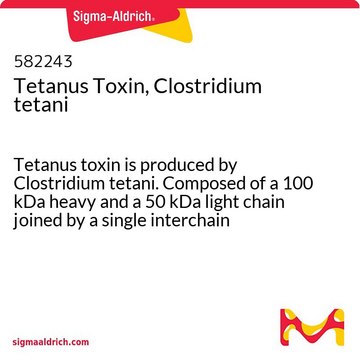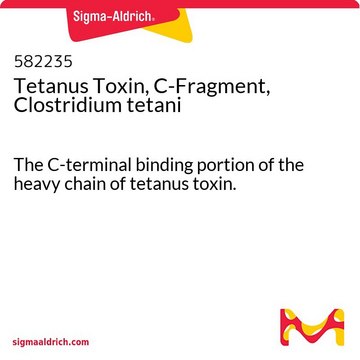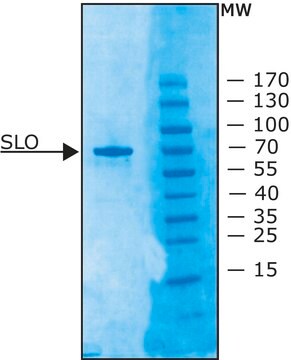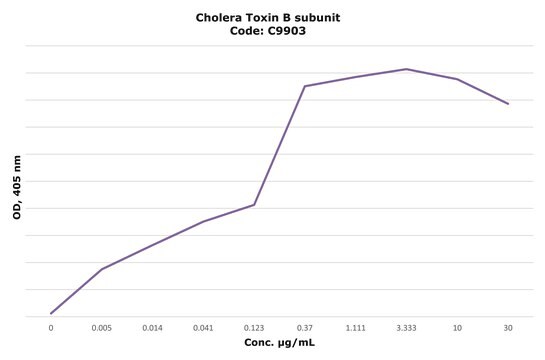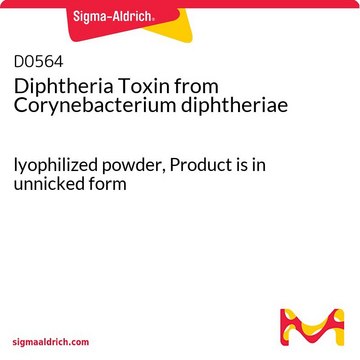T3694
Tetanus toxin C fragment from Clostridium tetani
Synonim(y):
TTC
Zaloguj sięWyświetlanie cen organizacyjnych i kontraktowych
About This Item
Polecane produkty
masa cząsteczkowa
apparent mol wt 47 kDa
Poziom jakości
kolor
white
rozpuszczalność
H2O: soluble
temp. przechowywania
2-8°C
Opis ogólny
Fragment C toksyny tężcowej (TTC) jest nietoksycznym peptydem, który jest transportowany z aksonów obwodowych do motoneuronów rdzeniowych. Zapewnia ochronę motoneuronów (MN) w rdzeniu kręgowym in vivo. TTC reguluje wiązanie błonowe, internalizację i transport wsteczny w MN. Inicjuje szlaki sygnałowe regulowane przez neurotrofiny w sposób zależny od receptora Trk. TTC ma właściwości neuroprotekcyjne w pierwotnej hodowli komórek ziarnistych móżdżku.
Zastosowanie
Część wiążąca terminal C toksyny tężcowej nie jest toksyczna, ale jest pobierana przez przedsynaptyczne zakończenia nerwowe i wykazuje trans-synaptyczny transport wsteczny w neuronach centralnych podobny do toksyny tężcowej.
Część wiążąca terminal C toksyny tężcowej nie jest toksyczna, ale jest pobierana przez przedsynaptyczne zakończenia nerwowe i wykazuje trans-synaptyczny transport wsteczny w neuronach centralnych podobny do toksyny tężcowej. Służy do mapowania połączeń neuronalnych i kierowania białek do neuronów.
Działania biochem./fizjol.
Toksyna tężcowa jest neurotoksyną, która składa się z łańcucha ciężkiego i lekkiego połączonych mostkami dwusiarczkowymi. Ta neurotoksyna wchodzi do cytoplazmy i uwalnia składnik łańcucha lekkiego, który następnie hamuje uwalnianie neuroprzekaźników2. Badania wykazały, że fragment C toksyny tężcowej zachowuje większość determinantów, które oddziałują z błonami tarczycy, gangliozydami i błonami nerwowymi3.
Rekonstytucja
Każda fiolka po rozpuszczeniu w 50 μl jałowej wody destylowanej zawiera 10 μg fragmentu C toksyny tężcowej w 0,01 M fosforanie sodu o pH 7,5. Aby wspomóc odzyskiwanie, można dodać 0,1% albuminy.
Ta strona może zawierać tekst przetłumaczony maszynowo.
Hasło ostrzegawcze
Danger
Zwroty wskazujące rodzaj zagrożenia
Zwroty wskazujące środki ostrożności
Klasyfikacja zagrożeń
Acute Tox. 1 Oral - Acute Tox. 2 Inhalation - STOT SE 1
Organy docelowe
Central nervous system
Kod klasy składowania
6.1A - Combustible acute toxic Cat. 1 and 2 / very toxic hazardous materials
Klasa zagrożenia wodnego (WGK)
WGK 3
Temperatura zapłonu (°F)
Not applicable
Temperatura zapłonu (°C)
Not applicable
Wybierz jedną z najnowszych wersji:
Masz już ten produkt?
Dokumenty związane z niedawno zakupionymi produktami zostały zamieszczone w Bibliotece dokumentów.
Klienci oglądali również te produkty
T B Helting et al.
The Journal of biological chemistry, 252(1), 187-193 (1977-01-10)
Tetanus toxin was digested with papain, yielding one major polypeptide (Fragment C) with a molecular weight corresponding to 47,000 +/- 5%, thus comprising about one-third of the toxin molecule. Fragment C was antigenically active, atoxic, and stimulated the formation of
Tetanus toxin C-fragment protects against excitotoxic spinal motoneuron degeneration in vivo
Netzahualcoyotzi C and Tapia R
Scientific Reports, 8(1), 16584-16584 (2018)
Interaction of fragments B and C of tetanus toxin with neural and thyroid membranes and with gangliosides.
N P Morris et al.
The Journal of biological chemistry, 255(13), 6071-6076 (1980-07-10)
E Link et al.
Biochemical and biophysical research communications, 189(2), 1017-1023 (1992-12-15)
Tetanus toxin is a potent neurotoxin that inhibits the release of neurotransmitters from presynaptic nerve endings. The mature toxin is composed of a heavy and a light chain that are linked via a disulfide bridge. After entry of tetanus toxin
Nasz zespół naukowców ma doświadczenie we wszystkich obszarach badań, w tym w naukach przyrodniczych, materiałoznawstwie, syntezie chemicznej, chromatografii, analityce i wielu innych dziedzinach.
Skontaktuj się z zespołem ds. pomocy technicznej


